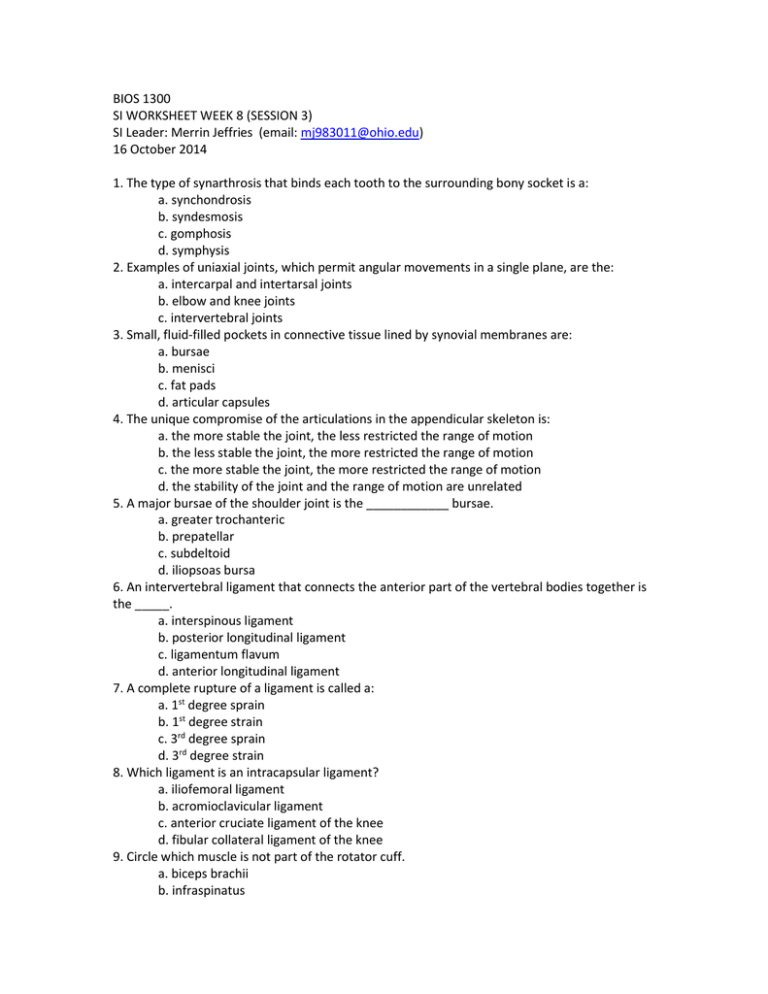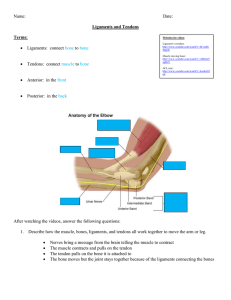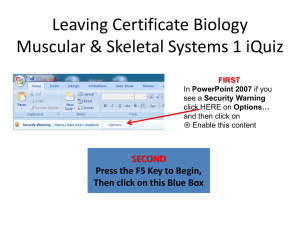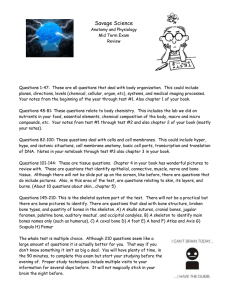BIOS 1300 SI WORKSHEET WEEK 8 (SESSION 3) SI Leader
advertisement

BIOS 1300 SI WORKSHEET WEEK 8 (SESSION 3) SI Leader: Merrin Jeffries (email: mj983011@ohio.edu) 16 October 2014 1. The type of synarthrosis that binds each tooth to the surrounding bony socket is a: a. synchondrosis b. syndesmosis c. gomphosis d. symphysis 2. Examples of uniaxial joints, which permit angular movements in a single plane, are the: a. intercarpal and intertarsal joints b. elbow and knee joints c. intervertebral joints 3. Small, fluid-filled pockets in connective tissue lined by synovial membranes are: a. bursae b. menisci c. fat pads d. articular capsules 4. The unique compromise of the articulations in the appendicular skeleton is: a. the more stable the joint, the less restricted the range of motion b. the less stable the joint, the more restricted the range of motion c. the more stable the joint, the more restricted the range of motion d. the stability of the joint and the range of motion are unrelated 5. A major bursae of the shoulder joint is the ____________ bursae. a. greater trochanteric b. prepatellar c. subdeltoid d. iliopsoas bursa 6. An intervertebral ligament that connects the anterior part of the vertebral bodies together is the _____. a. interspinous ligament b. posterior longitudinal ligament c. ligamentum flavum d. anterior longitudinal ligament 7. A complete rupture of a ligament is called a: a. 1st degree sprain b. 1st degree strain c. 3rd degree sprain d. 3rd degree strain 8. Which ligament is an intracapsular ligament? a. iliofemoral ligament b. acromioclavicular ligament c. anterior cruciate ligament of the knee d. fibular collateral ligament of the knee 9. Circle which muscle is not part of the rotator cuff. a. biceps brachii b. infraspinatus c. supraspinatus d. teres minor 10. Osteoarthritis is a. A progressive destruction of the cartilage b. a progressive destruction of the bone c. is due to an autoimmune disease d. is more prevalent in men compared to women Fill-in 1. Rheumatoid arthritis is a chronic, _____________________________ disease . 2. The annulus fibrous and the nucleus pulposus are structures composing the _____________________________ . 3. A rigid cartilaginous connection such as an epiphyseal plate is called a ___________________________________ . 5. A synarthrotic joint found only between the bones of the skull is a _______________________________ . 6. A localized mass of adipose tissue that protects articular cartilage is called a _____________________ . 8. The _______________________ deepens the socket of the glenoid cavity. 9. Synovial fluid is produced in the ____________________________________________ . 10. The patellar ligament attaches from the ________________________ to the __________________________. Answer the following matching questions. You may have more than one answers. Word Bank #1: Body Spinous process Transverse process Intervertebral foramen Superior articular process Transverse foramen _______________________ 1. Opening for the vertebral arteries _______________________2. Weight-bearing part of the vertebra _______________________3. Provide lever for the muscles to pull against _______________________4. Provide an articulation point for the vertebra above it _______________________5. Openings allowing spinal nerves to pass Word Bank #2: Acromion Humerus Phalanges Capitulum Olecranon fossa Ulnar styloid process Carpals Radius Trochlea Coracoid process Scapula Ulna Coronoid fossa Sternum Glenoid cavity Metacarpals _______________________1. Bone of the brachium _______________________2. Bones composing the shoulder girdle _______________________3. Forearm bones _______________________4. Point where scapula and clavicle connect _______________________5. Shoulder girdle bone that articulates anteriorly with the sternum _______________________6. Shoulder girdle bone that has no attachment to the axial skeleton _______________________7. Medial bone of the forearm _______________________8. Rounded knob on distal end of ulna _______________________9. The most anterior aspect of the scapula _______________________10. Heads of these bones form the knuckles _______________________ 11. Anterior depression; superior to the trochlea; receives part of ulna when forearm flexes _______________________12. Forearm bone involved in formation of the elbow joint _______________________13. Medial bone that articulates with the clavicle _______________________14. Bones of the wrist SHORT ANSWER: 1.When you run your finger along a person’s spine, what part of the vertebrae are you feeling just beneath the skin? 2. Why does the vertebral column of an adult have fewer vertebrae than that of a newborn? 3. Joe suffered a hairline fracture at the base of the dens. Which bone is fractured, and where is it located? 4. Why are the bodies of the lumbar vertebrae so large? 5. How are true ribs distinguished from false ribs? 6. Improper administration of cardiopulmonary resuscitation (CPR) can result in a fracture of which bone(s)? 7. Why would a broken clavicle affect the mobility of the scapula? 8. The rounded projections on either side of the elbow are part of which bone? 9. Bill accidentally fractures his first distal phalanx with a hammer. Which finger is broken? 10. How is the pelvis of females adapted for childbearing? 11. When you are seated, which part of the pelvis bears your body’s weight? 12. While jumping off the back steps at his house, 10-year-old Joey lands on his right heel and breaks his foot. Which foot bone is most likely broken? 13. Which foot bone transmits the weight of the body from the tibia toward the toes? 14. Compare and contrast the bones of males and females with respect to weight and surface markings. 15. An anthropologist discovered several bones in a deep grave. After close visual inspection and careful measurements, what sort of information could the bones reveal? 16. Why would a person suffering from osteoporosis be more likely to suffer a broken hip than a broken shoulder? 17. Mary is in her last month of pregnancy and is suffering from lower back pains. Since she is carrying excess weight in front of her, she wonders why her back hurts. What would you tell her? 18. While Brad, a fireman, is fighting a fire in a building, part of the ceiling collapses, and a beam strikes him on his left shoulder. He is rescued, but has a great deal of pain in his shoulder. He cannot move his arm properly, especially in the anterior direction. His clavicle is not broken, and his humerus is intact. What is the probable nature of Brad’s injury? LABEL the parts of the SHOULDER JOINT





